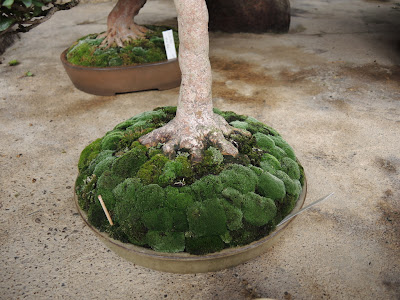 |
| Kuchinashi - Gardenia |
The tokonoma is a recessed alcove found in traditional Japanese rooms such as guest rooms, tea rooms and meeting halls. It's been an essential part of Japanese architecture for hundreds of years, being a principal place for the display of art and pretty things. These days few Japanese homes have them, tatami rooms are unpopular and where the space is available, it's sometimes covered with doors and used for storage.
 |
| Most of our tables. Is there ever such a thing as enough storage space? |
Putting together a display is a fun challenge of one's aesthetic senses. We mostly go by gut feeling in judging whether the display is harmonious or not, though Mr Kobayashi is sure to "tune" that feeling when we get it wrong.
First we choose a healthy tree suitable for the size of the tokonoma we are filling. Then we choose a table for the tree, this is often where we struggle the most to find a good fit, even though we are fortunate to have quite a collection to choose from. Finding the right width is easy, and we look for a table with power and strength to match the tree, with slender light tables for maples and thick heavy powerful tables for big rough pines.
The tricky part is finding a good height, especially since we don't want to match any of the platforms in the left and right of the tokonoma while also considering the width and height of the pot, trunk and foliage. We often try out a few tables with the tree in the tokonoma before deciding on the best match.
The tree and table is put in the left or right side of the tokonoma depending on the direction of the tree.
Finally we pick a suitable scroll and accent. I'm still pretty lost in this department, but I'm starting to appreciate the use of accent plants, "kusamono", to express a season or environment together with the other pieces in the display.
 |
| The only table we could find that fit the description of Fukita-san, but it's too big, overpowering the tree. |
We had earlier found this table, but upon seeing a picture of the tree, he immediately thought of a table he knew that we had that would be the perfect fit. All if the tables matching his description were way too big, so we tried with a few other ones, but he was hard to please. Eventually we found his table in one of our pot-rooms, and I have to agree it was a good fit. He mentioned the fact that the foliage curls inward at the bottom, this is picked up much better with the final table compared with one with straight legs. He got all excited talking about the table, saying that this particular one could match almost any tree of the right size, and bring out its best features.
 |
| My suggestion, in place of the one we we couldn't find |
We also discussed the direction of the tree. We had earlier incorrectly placed it to the right in the tokonoma, seeing it as a left-facing tree. He said that many of its features are indeed going towards the left, but we missed the obvious fact that it's planted slightly offset to left, indicating that the maker's intention is to have it going to the right. Looking closer, we can also see that the foliage is much more sparse and held back on the left side while it is let to grow out on the right side. In fact, it is Mr Kobayashi who has his mind set on making it right-facing, and it was Fukita-san and Peter Warren who last repotted it.
 |
| Found it! I have to admit it's a pretty good fit. |
Fukita-san also turned our attention to the beauty of a tree that has not been touched for some time, giving it a natural roundness and irregularity that simply cannot be emulated.
Splendour in a pot.
Here's for short, concise and frequent blog posts in the future :)
 |
| "...Now how about if you did this? Make any sense?" |












